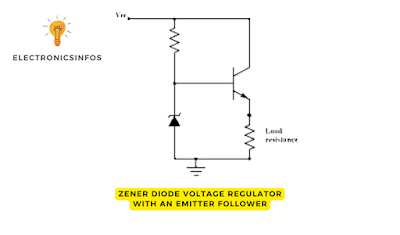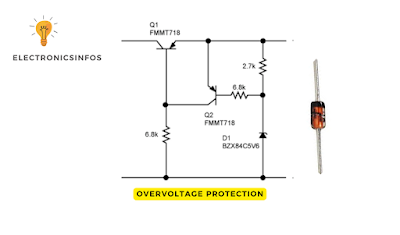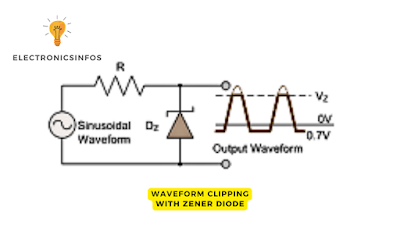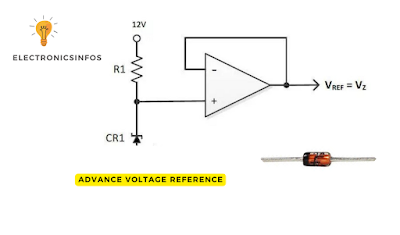Wonders of Zener Diodes 2024
In the era of power electronics, the Zener diode device plays an important role in voltage regulation and protection within electronic circuits. Named after physicist Clarence Zener, who discovered the Zener effect. In this article, we discuss a journey to the mysteries of Zener diodes, exploring their fundamental characteristics, applications, and the unique phenomena that make them useful in electronics.
 |
| Wonders of Zener Diode 2024- Electronicsinfos |
The Basics of Zener Diodes
A Zener diode appears similar to a regular semiconductor diode, but its behaviour sets it apart. Zener diodes operate with the Zener effect, a phenomenon where a diode operates in the reverse breakdown, allowing a controlled and constant voltage to be maintained across its terminals.
Zener Diode Symbol
 |
| Zener diode |
Zener diodes are special types of semiconductor diodes that operate in the reverse breakdown region. Unlike regular diodes, designed to allow current to flow in one direction only, Zener diodes are conducted in the reverse direction when a Zener voltage is reached.
Zener diode characteristics
- Forward Bias Characteristics
- Reverse Bias Characteristics
Zener diode basic terminologies
- Zener Voltage (Vz)
- Zener Diode
- Reverse Bias
- Reverse Current (Zener Current)
- Knee Voltage
- Voltage regulator
- Breakdown Region
- Zener Resistance
- Forward Bias
- Cut-in Voltage
Breakdown Voltage (Zener Voltage)
Zener Diode
Reverse Bias
Reverse Current (Zener Current)
Knee Voltage
Voltage Regulator
Breakdown Region
Zener Resistance (Dynamic Resistance)
Forward Bias
Cut-In Voltage
Applications of Zener Diodes
let's explore the applications of Zener diodes in the field of electronics
- Voltage Regulation
- Voltage Reference
- Overvoltage Protection
- Waveform Clipping
- Temperature Compensation
Advance Voltage Regulation
Advanced voltage regulation with a Zener diode involves addressing some of the limitations of basic Zener diode regulators, such as sensitivity to variations in load current and input voltage. One common improvement is to use an additional transistor in conjunction with the Zener diode. This configuration is known as a "Zener diode voltage regulator with an emitter follower.
Here's how you can implement an advanced voltage regulator using a Zener diode and an NPN transistor
 |
| Zener diode voltage regulator with an emitter follower |
Working Principle
- When the input voltage increases, the Zener diode maintains a relatively constant voltage across its terminals.
- The transistor operates in the emitter-follower configuration, where the emitter voltage follows the base voltage minus the diode drop.
- This setup allows for better stability against changes in load current and input voltage.
Benefits of voltage regulators
- Improved stability against variations in load current and input voltage.
- Better efficiency compared to a simple Zener diode regulator.
Zener diodes are extensively used for voltage regulation in power supplies. By connecting a Zener diode in reverse across the load, a constant output voltage can be maintained, preventing voltage fluctuations and ensuring a stable power source.
Top Performance factor of Logic gates 2024
Voltage Regulation Equation
The voltage regulation can be described by the following equation
Where
- Vz is the Zener voltage
- IZ is the Zener current flowing through the Zener diode.
- Rs is the series resistor.
Advance Voltage Reference
Working Principle
- The Zener diode provides a stable reference voltage, but it may be sensitive to temperature changes.
- The voltage reference IC, being a precision device, provides a stable and accurate reference voltage with minimal sensitivity to temperature variations.
- The operational amplifier compares the voltages from the Zener diode and the voltage reference IC.
- The feedback loop adjusts the output voltage to minimize the difference between the Zener voltage and the voltage reference IC's output, resulting in a more stable and accurate output voltage.
Benefits of Voltage Reference
- Improved accuracy and stability compared to a standalone Zener diode voltage reference.
- Reduced sensitivity to temperature variations.
- The ability to achieve precise voltage levels for critical applications.
Overvoltage Protection
Overvoltage protection using a Zener diode involves using the diode to clamp the voltage across a circuit, preventing it from exceeding a certain predetermined level. This is commonly employed to safeguard electronic components from potential damage due to voltage spikes or surges. Here's a basic explanation of how you can implement overvoltage protection using a Zener diode
Working Principle
 |
| Overvoltage protection |
- Under normal operating conditions, the Zener diode remains in the reverse-biased mode, and no current flows through it.
- When the voltage across the Zener diode exceeds its breakdown voltage (Zener voltage), the diode enters the breakdown region and begins to conduct.
- The Zener diode clamps the voltage across the load to its breakdown voltage, preventing it from exceeding this level.
Benefits of overvoltage protection
- The Zener diode prevents the voltage across the load from going beyond a specified level.
- Zener diodes respond quickly to voltage spikes, providing rapid protection.
In this circuit, the Zener diode only conducts when the voltage across it exceeds the breakdown voltage. The series resistor limits the current flowing through the Zener diode to prevent excessive power dissipation.
Zener diodes act as guardians against overvoltage conditions. Placed in parallel with sensitive electronic components, they clamp the voltage across the component, preventing damage due to voltage spikes.
Waveform Clipping
Zener diodes are employed for waveform clipping in signal-processing circuits. By limiting the amplitude of input signals, Zener diodes help shape waveforms and protect subsequent components from excessive voltages.
Waveform clipping using a Zener diode involves using the diode to limit the amplitude of a signal by clipping off the excess voltage above a certain level. This is commonly employed in electronic circuits to prevent signal distortion or to protect downstream components from excessively high voltages. Here's a basic explanation of how you can implement waveform clipping using a Zener diode
 |
| waveform clipping |
Working Principle
- Under normal conditions, when the input signal voltage is below the Zener voltage, the Zener diode remains non-conductive, and the signal passes through unaffected.
- When the input signal voltage exceeds the Zener voltage, the Zener diode starts to conduct and clamps the signal voltage to its breakdown voltage.
- The excess voltage above the Zener voltage is clipped off, resulting in a clipped waveform.
Benefits of Waveform Clipping
- The Zener diode clips the signal voltage above its breakdown voltage, preventing it from exceeding a specified level.
- Protects downstream components from high voltage levels.
Temperature Compensation
Conclusion
Zener diodes emerge as silent architects of stability and precision in the intricate tapestry of electronic components. Their ability to maintain a constant voltage under reverse breakdown, coupled with a myriad of applications, establishes them as indispensable components in modern electronics. As technology advances, the role of Zener diodes will likely evolve, contributing to the ever-expanding landscape of electronic innovation.
Frequently Asked Questions – FAQs
What is a Zener diode?
A Zener diode is a type of semiconductor diode that operates in the reverse-biased breakdown region, known as the Zener breakdown region. The Flow of Current in Zener Diode in both directions: Forward and reverse
What is the operation of Zener Diode?
A Zener diode allows current to flow in the reverse direction from the cathode to the anode, once the voltage across it reaches a specific value called the Zener voltage. This characteristic makes Zener diodes useful for maintaining a constant voltage across a load.
What is the difference between a Zener diode and a regular diode?
The main difference is in their operating regions. Regular diodes are designed to conduct current forward and block it in the reverse direction. On the other hand, Zener diodes are designed to conduct in the reverse direction when a Zener voltage is applied.
What are the applications of Zener diodes?
Zener diodes are used in various applications, including voltage regulation, voltage reference circuits, overvoltage protection, surge suppression, and voltage clamping circuits.
How is the Zener voltage of a diode determined?
The Zener voltage of a diode is determined during the manufacturing process by adjusting the doping concentration and physical structure of the diode.
What is the temperature coefficient of a Zener diode?
The temperature coefficient (αz) of a Zener diode is the rate of change of its Zener voltage with temperature. It is expressed in millivolts per degree Celsius (mV/°C).
Related Posts



-Electronicsinfos.png)
.png)


0 Comments
please do not insert spam links